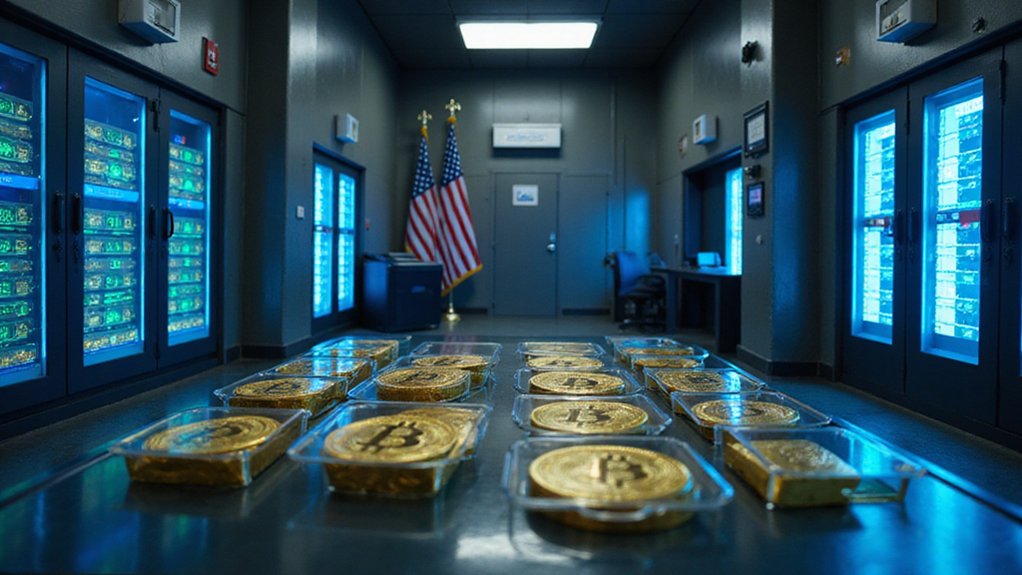The U.S. government has inadvertently become crypto’s biggest hodler, amassing over 200,000 bitcoins valued in the billions—primarily through criminal seizures. What began as law enforcement’s digital detritus has transformed into a strategic national reserve formalized by Executive Order 2025-03-06. This stockpile, fragmented across Justice, Treasury, and the Marshals Service, now serves multiple policy objectives despite management challenges. The implications of Uncle Sam’s bitcoin stash extend far beyond Washington’s beltway into a nascent global digital monetary race.

The United States government has quietly amassed what has become the world’s largest state-owned bitcoin reserve, with holdings exceeding 200,000 BTC as of March 2025—a stockpile worth tens of billions of dollars at current valuations.
The U.S. government now reigns as crypto’s reluctant kingpin, sitting atop a bitcoin fortune never intended for federal coffers.
These digital assets, primarily accumulated through forfeitures from illicit activity seizures, represent an unprecedented foray into cryptocurrency by a sovereign nation.
What began as a byproduct of law enforcement actions has evolved into a strategic reserve that the administration appears determined to maintain rather than liquidate.
The custody framework governing these assets remains remarkably fragmented—a patchwork system distributed across the Department of Justice, Treasury, and Marshals Service, with third-party custodians handling secure storage.
This decentralized approach (reminiscent of how the government initially handled gold reserves before centralization) creates operational friction that belies the supposedly frictionless nature of digital assets.
Executive Order 2025-03-06 formalized the creation of this reserve, signaling intentions beyond mere asset management.
The administration’s stated objectives—economic sovereignty, positioning the U.S. as the “crypto capital of the world,” and hedging against economic sanctions—suggest a sophisticated understanding of cryptocurrency’s geopolitical implications.
Bitcoin’s status as digital gold with a fixed supply cap of 21 million coins makes it particularly valuable for long-term strategic reserves.
The executive order explicitly commits that the United States will adopt a no-selling policy for all bitcoin deposited into the Strategic Bitcoin Reserve.
Who would have anticipated the government that once auctioned seized bitcoin would eventually hoard it?
This development has catalyzed similar initiatives globally, with competing nations exploring state-backed crypto reserves—creating an unexpected digital arms race with profound implications for monetary sovereignty.
The challenges facing federal crypto managers are not trivial: price volatility management, cold storage security at national scale, and establishing valuation standards all require expertise scarcely found in government corridors.
The reserve’s management includes sophisticated volatility hedging strategies to mitigate the risks associated with bitcoin’s price fluctuations while maintaining long-term holdings.
Looking ahead, expansion beyond bitcoin seems inevitable, as does increased congressional oversight.
The nascent stockpile represents both opportunity and contradiction—a government historically skeptical of cryptocurrency now possesses one of the most significant positions in an asset class designed to circumvent state control.
Whether this strategic pivot proves prescient or problematic remains to be seen.
Frequently Asked Questions
How Does the Government Secure Its Cryptocurrency Wallets?
The government employs multi-layered security for cryptocurrency wallets, combining multi-signature approvals, role-based access controls, and hardware security modules for tamper-proof key storage.
Federal crypto holdings typically reside in cold storage solutions isolated from internet access, with keys segregated across agencies or geographical locations.
Time-locked transactions and strict OFAC compliance mechanisms prevent unauthorized transfers, while thorough audit protocols—including third-party verification and immutable blockchain records—maintain operational integrity.
The system effectively weaponizes bureaucracy against potential threats.
Are Federal Crypto Holdings Audited by Independent Third Parties?
Federal crypto holdings typically undergo independent third-party audits, with agencies like the U.S. Marshals Service employing specialized custodians and auditing firms to verify asset integrity.
These audits—essential for compliance with AML regulations and OFAC requirements—involve multi-signature wallet verification and provenance confirmation.
While the government maintains oversight, independent verification provides necessary public accountability.
The nascent Strategic Bitcoin Reserve initiative has accelerated formalization of these audit frameworks, though resource constraints remain a persistent challenge.
Which Federal Agencies Own the Largest Crypto Portfolios?
Based on available information, the Treasury Department emerges as the primary crypto custodian, managing the strategic “digital Fort Knox” with the largest Bitcoin reserves collected primarily through asset seizures.
The DOJ likely maintains substantial holdings from high-profile criminal cases (think Silk Road), while the FBI, Homeland Security, and IRS Criminal Investigation division round out the federal crypto portfolio landscape—each holding assets obtained through their respective enforcement activities in cybercrime, border security, and tax evasion cases.
Has the Government Ever Lost Access to Its Crypto Assets?
The U.S. government has indeed experienced crypto asset mishaps.
Most particularly, a government-controlled wallet containing $20 million in crypto (proceeds from the 2016 Bitfinex hack) was breached, though remarkably, most funds were subsequently returned by the hacker.
The U.S. Marshals Service has struggled with basic inventory management, often unable to provide precise estimates of holdings.
Insufficient security protocols—including the transmission of sensitive information via unencrypted emails—have exacerbated vulnerability concerns, despite no reported catastrophic losses to date.
What Legislation Governs How Federal Agencies Can Use Seized Cryptocurrencies?
Federal agencies’ handling of seized cryptocurrencies is primarily governed by the Money Laundering Control Act and Civil Asset Forfeiture laws, which permit seizure without criminal conviction in certain circumstances.
The Digital Asset Forfeiture Program, managed by the DOJ, provides operational oversight.
The Bank Secrecy Act supplies additional authority through suspicious transaction reporting requirements.
Recent executive orders have further formalized the integration of seized digital assets into broader federal strategy, shifting from mere liquidation toward strategic retention.









